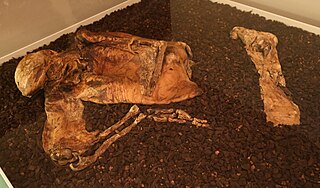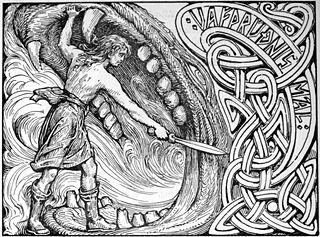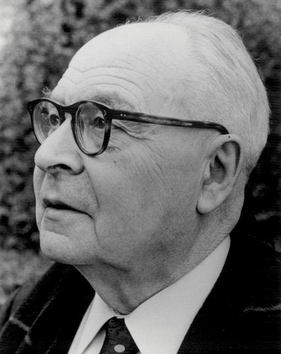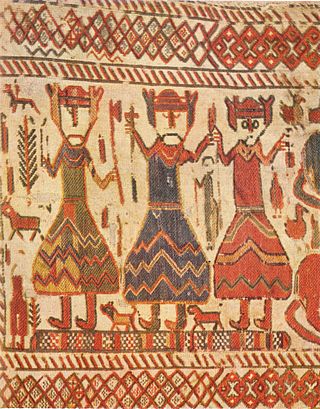Related Research Articles

Lindow Man, also known as Lindow II and as Pete Marsh, is the preserved bog body of a man discovered in a peat bog at Lindow Moss near Wilmslow in Cheshire, North West England. The remains were found on 1 August 1984 by commercial peat cutters. Lindow Man is not the only bog body to have been found in the moss; Lindow Woman was discovered the year before, and other body parts have also been recovered. The find was described as "one of the most significant archaeological discoveries of the 1980s" and caused a media sensation. It helped invigorate study of British bog bodies, which had previously been neglected.

In Norse mythology, Víðarr is a god among the Æsir associated with vengeance. Víðarr is described as the son of Odin and the jötunn Gríðr and is foretold to avenge his father's death by killing the wolf Fenrir at Ragnarök, a conflict he is described as surviving. Víðarr is attested in the Poetic Edda, compiled in the 13th century from earlier traditional sources, the Prose Edda, written in the 13th century by Snorri Sturluson, and is interpreted as depicted with Fenrir on the Gosforth Cross. A number of theories surround the figure, including theories around potential ritual silence and a Proto-Indo-European basis.

Proto-Indo-European mythology is the body of myths and deities associated with the Proto-Indo-Europeans, speakers of the hypothesized Proto-Indo-European language. Although the mythological motifs are not directly attested – since Proto-Indo-European speakers lived in preliterate societies – scholars of comparative mythology have reconstructed details from inherited similarities found among Indo-European languages, based on the assumption that parts of the Proto-Indo-Europeans' original belief systems survived in the daughter traditions.

Georges Edmond Raoul Dumézil was a French philologist, linguist, and religious studies scholar who specialized in comparative linguistics and mythology. He was a professor at Istanbul University, École pratique des hautes études and the Collège de France, and a member of the Académie Française. Dumézil is well known for his formulation of the trifunctional hypothesis on Proto-Indo-European mythology and society. His research has had a major influence on the fields of comparative mythology and Indo-European studies.

Bernard Sergent is a French ancient historian and comparative mythologist. He is researcher of the CNRS and president of the Société de mythologie française.

Germanic paganism or Germanic religion refers to the traditional, culturally significant religion of the Germanic peoples. With a chronological range of at least one thousand years in an area covering Scandinavia, the British Isles, modern Germany, and at times other parts of Europe, the beliefs and practices of Germanic paganism varied. Scholars typically assume some degree of continuity between Roman-era beliefs and those found in Norse paganism, as well as between Germanic religion and reconstructed Indo-European religion and post-conversion folklore, though the precise degree and details of this continuity are subjects of debate. Germanic religion was influenced by neighboring cultures, including that of the Celts, the Romans, and, later, by the Christian religion. Very few sources exist that were written by pagan adherents themselves; instead, most were written by outsiders and can thus present problems for reconstructing authentic Germanic beliefs and practices.

Proto-Indo-European society is the reconstructed culture of Proto-Indo-Europeans, the ancient speakers of the Proto-Indo-European language, ancestor of all modern Indo-European languages.

Diarmait mac Cerbaill was King of Tara or High King of Ireland. According to traditions, he was the last High King to follow the pagan rituals of inauguration, the ban-feis or marriage to goddess of the land. The last High King to observe the ancient pagan Feis Temrach or Assembly of Tara which took place on Samhain every three years to pass or renew laws, approve annals and records.

The trifunctional hypothesis of prehistoric Proto-Indo-European society postulates a tripartite ideology reflected in the existence of three classes or castes—priests, warriors, and commoners —corresponding to the three functions of the sacral, the martial and the economic, respectively. The trifunctional thesis is primarily associated with the French mythographer Georges Dumézil, who proposed it in 1929 in the book Flamen-Brahman, and later in Mitra-Varuna.

Ancient Celtic religion, commonly known as Celtic paganism, was the religion of the ancient Celtic peoples of Europe. Because there are no extant native records of their beliefs, evidence about their religion is gleaned from archaeology, Greco-Roman accounts, and literature from the early Christian period. Celtic paganism was one of a larger group of polytheistic Indo-European religions of Iron Age Europe.
A triple deity is a deity with three apparent forms that function as a singular whole. Such deities may sometimes be referred to as threefold, tripled, triplicate, tripartite, triune, triadic, or as a trinity. The number three has a long history of mythical associations and triple deities are common throughout world mythology. Carl Jung considered the arrangement of deities into triplets an archetype in the history of religion.

The Archaic Triad is a hypothetical divine triad, consisting of the three allegedly original deities worshipped on the Capitoline Hill in Rome: Jupiter, Mars and Quirinus. This structure was no longer clearly detectable in later times, and only traces of it have been identified from various literary sources and other testimonies. Many scholars dispute the validity of this identification.

Edward Oswald Gabriel Turville-Petre was an English philologist who specialized in Old Norse studies.

In Norse mythology, the Æsir–Vanir War was a conflict between two groups of deities that ultimately resulted in the unification of the Æsir and the Vanir into a single pantheon. The war is an important event in Norse mythology, and the implications for the potential historicity surrounding accounts of the war are a matter of scholarly debate and discourse.

Norse, Nordic, or Scandinavian mythology, is the body of myths belonging to the North Germanic peoples, stemming from Old Norse religion and continuing after the Christianization of Scandinavia, and into the Nordic folklore of the modern period. The northernmost extension of Germanic mythology and stemming from Proto-Germanic folklore, Norse mythology consists of tales of various deities, beings, and heroes derived from numerous sources from both before and after the pagan period, including medieval manuscripts, archaeological representations, and folk tradition. The source texts mention numerous gods such as the thunder-god Thor, the raven-flanked god Odin, the goddess Freyja, and numerous other deities.
Udo Mario Strutynski is an Austrian-born American linguist and lawyer. As a linguist, Strutynski specializes in Indo-European and Germanic studies, particularly the study of Germanic and Indo-European mythology. As a lawyer he has distinguished himself to helping out victims of the sexual abuse scandal in the Catholic archdiocese of Los Angeles, of which he is himself a survivor.
Atsuhiko Yoshida is a Japanese classical scholar best known for his research on parallels between Indo-European and Japanese mythology.
*Manu and *Yemo were a duo in Proto-Indo-European mythology. In the creation myth, Manu kills Yemo as a foundational part of the origin of the universe. Yemo is sometimes also interpreted as a primordial hermaphrodite.
*Trito is a significant figure in Proto-Indo-European mythology, representing the first warrior and acting as a culture hero. He is connected to other prominent characters, such as Manu and Yemo, and is recognized as the protagonist of the myth of the warrior function, establishing the model for all later men of arms. In the legend, Trito is offered cattle as a divine gift by celestial gods, which is later stolen by a three-headed serpent named *H₂n̥gʷʰis ('serpent'). Despite initial defeat, Trito, fortified by an intoxicating drink and aided by the Sky-Father, or alternatively the Storm-God or *H₂nḗr, 'Man', together they go to a cave or a mountain, and the hero overcomes the monster and returns the recovered cattle to a priest for it to be properly sacrificed. He is now the first warrior, maintaining through his heroic deeds the cycle of mutual giving between gods and mortals. Scholars have interpreted the story of Trito either as a cosmic conflict between the heavenly hero and the earthly serpent or as an Indo-European victory over non-Indo-European people, with the monster symbolizing the aboriginal thief or usurper. Trito's character served as a model for later cattle raiding epic myths and was seen as providing moral justification for cattle raiding. The legend of Trito is generally accepted among scholars and is recognized as an essential part of Proto-Indo-European mythology, although not to the level of Manu and Yemo.

Mitra-Varuna is a proposed deity or dyad of deities suggested to have existed in Proto-Indo-European religion and mythology. First proposed by Georges Dumézil, he considered it to have been composed of two distinct elements – Mitra and Varuna – this divine pair represented different aspects of sovereignty, with Mitra embodying reason, order, and benevolence, and Varuna symbolizing violence, darkness, and inspiration.
References
- 1 2 Mallory, J. P., Adams, Douglass Q., Encyclopedia of Indo-European Culture, p. 577
- ↑ Bragg, Melvyn, "Merlin" In Our Time 30 June 2005, BBC4, http://www.bbc.co.uk/radio4/history/inourtime/inourtime_20050630.shtml
- ↑ Lucan, "Pharsalia", I.441–446 http://www.perseus.tufts.edu/hopper/text.jsp?doc=Luc.+1.441&fromdoc=Perseus%3Atext%3A1999.02.0133 Trans. James Kennedy 2008
- ↑ Green, Miranda J. Dictionary of Celtic Myth and Legend. Pg. 85. New York: Thames and Hudson, 1992. ISBN 0-500-27975-6.
- ↑ Evans, David. "Agamemnon and the Indo-European Threefold Death Pattern." History of Religions, Vol. 19, No. 2 (Nov., 1979), pp. 153–166 JSTOR 1062271
- ↑ Columba, I. 29. Retrieved from https://archive.org/stream/lifeofsaintcolum00adamuoft/lifeofsaintcolum00adamuoft_djvu.txt on 24 December 2008
- ↑ Mallory, J. P., Adams, Douglass Q., Encyclopedia of Indo-European Culture, Pg. 635
- ↑ Miller, Dean (1997). "Threefold death". In Mallory, J. P.; Adams, Douglas Q. (eds.). Encyclopedia of Indo-European Culture . Taylor & Francis. pp. 577–578.
- ↑ Brothwell 1995 , p. 100
- ↑ Joy 2009 , p. 55
- ↑ Hodgson & Brennand 2006 , pp. 55–56
- ↑ Philpott 2006 , p. 79
- ↑ Joy 2009 , p. 45
- ↑ Joy 2009 , p. 23
- ↑ Joy 2009 , p. 48
Bibliography
- Brothwell, Don (1995). "Recent Research on the Lindow Bodies in the Context of Five Years of World Studies". Bog Bodies: New Discoveries and New Perspectives. British Museum Press. pp. 100–103. ISBN 0-7141-2305-6.
- Dumézil, Georges (1983). The Stakes of the Warrior. University of California Press. ISBN 978-0-520-04834-8.
- Eson, Lawrence (2010). "Odin and Merlin: Threefold Death and the World Tree". Western Folklore. 69 (1): 85–107. ISSN 0043-373X. JSTOR 25735286.
- Evans, David (1979). "Agamemnon and the Indo-European Threefold Death Pattern". History of Religions. 19 (2): 153–166. doi:10.1086/462841. ISSN 0018-2710. S2CID 162358300.
- Hodgson, John; Brennand, Mark (2006). "The Prehistoric Period Resource Assessment". The Archaeology of North West England: An Archaeological Framework for North West England. The Association for Local Government Archaeological Officers and English Heritage with The Council for British Archaeology North West. 8 (18): 23–58. ISSN 0962-4201.
- Joy, Jody (2009). Lindow Man. British Museum Press. ISBN 978-0-7141-2817-7.
- Lacy, Alan F. (1980). "Some Additional Celtic and Germanic Traces of the Tri-Functional Sacrifice". The Journal of American Folklore. 93 (369): 337–341. doi:10.2307/540581. ISSN 0021-8715. JSTOR 540581.
- Mallory, James P.; Adams, Douglas Q. (1997). Encyclopedia of Indo-European Culture. London: Routledge. ISBN 978-1-884964-98-5. (EIEC).
- Philpott, Rob (2006), "The Romano-British Period Resource Assessment", The Archaeology of North West England: An Archaeological Framework for North West England, The Association for Local Government Archaeological Officers and English Heritage with The Council for British Archaeology North West, 8 (18): 59–90, ISSN 0962-4201
- Ward, D. J. (1970). "The three-fold death, an Indo-European trifunctional sacrifice?". In Puhvel, Jaan (ed.). Myth and law among the Indo-Europeans: studies in Indo-European comparative mythology. University of California Press. ISBN 9780520015876.